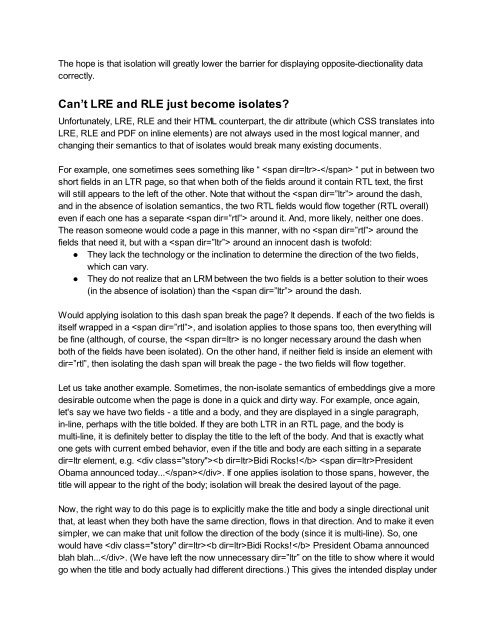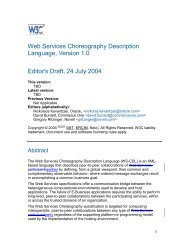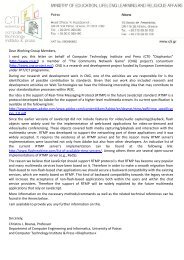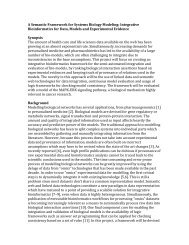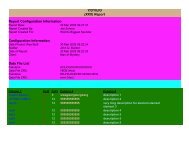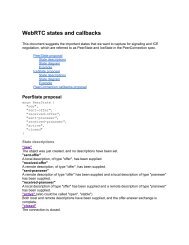A Proposal for Bidi Isolates in Unicode
A Proposal for Bidi Isolates in Unicode
A Proposal for Bidi Isolates in Unicode
Create successful ePaper yourself
Turn your PDF publications into a flip-book with our unique Google optimized e-Paper software.
The hope is that isolation will greatly lower the barrier <strong>for</strong> display<strong>in</strong>g opposite-diectionality data<br />
correctly.<br />
Can’t LRE and RLE just become isolates?<br />
Un<strong>for</strong>tunately, LRE, RLE and their HTML counterpart, the dir attribute (which CSS translates <strong>in</strong>to<br />
LRE, RLE and PDF on <strong>in</strong>l<strong>in</strong>e elements) are not always used <strong>in</strong> the most logical manner, and<br />
chang<strong>in</strong>g their semantics to that of isolates would break many exist<strong>in</strong>g documents.<br />
For example, one sometimes sees someth<strong>in</strong>g like “ - “ put <strong>in</strong> between two<br />
short fields <strong>in</strong> an LTR page, so that when both of the fields around it conta<strong>in</strong> RTL text, the first<br />
will still appears to the left of the other. Note that without the around the dash,<br />
and <strong>in</strong> the absence of isolation semantics, the two RTL fields would flow together (RTL overall)<br />
even if each one has a separate around it. And, more likely, neither one does.<br />
The reason someone would code a page <strong>in</strong> this manner, with no around the<br />
fields that need it, but with a around an <strong>in</strong>nocent dash is twofold:<br />
● They lack the technology or the <strong>in</strong>cl<strong>in</strong>ation to determ<strong>in</strong>e the direction of the two fields,<br />
which can vary.<br />
● They do not realize that an LRM between the two fields is a better solution to their woes<br />
(<strong>in</strong> the absence of isolation) than the around the dash.<br />
Would apply<strong>in</strong>g isolation to this dash span break the page? It depends. If each of the two fields is<br />
itself wrapped <strong>in</strong> a , and isolation applies to those spans too, then everyth<strong>in</strong>g will<br />
be f<strong>in</strong>e (although, of course, the is no longer necessary around the dash when<br />
both of the fields have been isolated). On the other hand, if neither field is <strong>in</strong>side an element with<br />
dir=”rtl”, then isolat<strong>in</strong>g the dash span will break the page - the two fields will flow together.<br />
Let us take another example. Sometimes, the non-isolate semantics of embedd<strong>in</strong>gs give a more<br />
desirable outcome when the page is done <strong>in</strong> a quick and dirty way. For example, once aga<strong>in</strong>,<br />
let's say we have two fields - a title and a body, and they are displayed <strong>in</strong> a s<strong>in</strong>gle paragraph,<br />
<strong>in</strong>-l<strong>in</strong>e, perhaps with the title bolded. If they are both LTR <strong>in</strong> an RTL page, and the body is<br />
multi-l<strong>in</strong>e, it is def<strong>in</strong>itely better to display the title to the left of the body. And that is exactly what<br />
one gets with current embed behavior, even if the title and body are each sitt<strong>in</strong>g <strong>in</strong> a separate<br />
dir=ltr element, e.g. <strong>Bidi</strong> Rocks! President<br />
Obama announced today.... If one applies isolation to those spans, however, the<br />
title will appear to the right of the body; isolation will break the desired layout of the page.<br />
Now, the right way to do this page is to explicitly make the title and body a s<strong>in</strong>gle directional unit<br />
that, at least when they both have the same direction, flows <strong>in</strong> that direction. And to make it even<br />
simpler, we can make that unit follow the direction of the body (s<strong>in</strong>ce it is multi-l<strong>in</strong>e). So, one<br />
would have <strong>Bidi</strong> Rocks! President Obama announced<br />
blah blah.... (We have left the now unnecessary dir=”ltr” on the title to show where it would<br />
go when the title and body actually had different directions.) This gives the <strong>in</strong>tended display under


